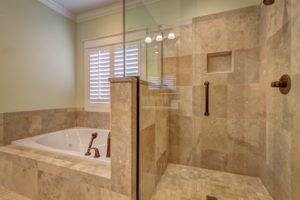 One can not be 100% sure of the quality of repairs in the bathroom if the walls and floor are not waterproofed. Creation of a hydrobarrier is necessary, since in buildings with high humidity (and the bathroom is just such a room), building materials will become useless after a while and are destroyed.
One can not be 100% sure of the quality of repairs in the bathroom if the walls and floor are not waterproofed. Creation of a hydrobarrier is necessary, since in buildings with high humidity (and the bathroom is just such a room), building materials will become useless after a while and are destroyed.
Choice of materials
Waterproofing is laying under the finishing materials of an additional layer, which has an increased level of moisture resistance. The higher the moisture resistance of the material and the quality of the work performed, the more reliable the barrier will be.
Manufacturers of building materials offer a variety of tools used to create a waterproofing layer. These are various materials with a layer of bitumen or bitumen mastic, cement-polymer solutions, rubber and penetrating waterproofing agents applied on them. It is undesirable to use various polyethylene materials, since the level of vapor permeability of these does not correspond to the norms necessary for these purposes.
Not everyone has the opportunity to use the construction team for complete bathroom repair. Part of the work can be done independently, including the installation of a waterproofing layer.
To install the insulator with your own hands, it’s better to stop on bituminous mastic and materials with similar impregnation. The combination of these materials will create the most effective protection of the finish layer of wall surfaces and the floor in the bathroom.
The order of insulating installation
Installation of waterproofing coating is carried out in several steps. First remove the previous floor covering completely, to the base. Then the laying of new layers begins.
Initially, the concrete base is thoroughly cleaned from the remnants of the coating and dirt and a primer coat is applied. Primer coating is better to use deep penetration. It improves the degree of adhesion to the surface.
Modern building technologies make it possible to use a special primer, with elements of penetrating waterproofing. Such a mixture penetrates into all the smallest cracks, and crystallizes fills them. After the primer has dried completely, a bitumen mastic solution is applied with a brush. Especially carefully should handle the joints of the floor with the wall.
In the places of communication on top of pipes it is better to put on rubber seals and to process them with mastic. Above the layer of bituminous mastic, the insulating material is laid overlapping and turning onto the walls.
In places where the material is overlapped, an additional layer of mastic is applied. In this case, you need to carefully monitor the places of the joint of the floor with the wall. Here, in no case should there be stitches to prevent moisture from passing through.
To improve the insulation on the pipes, the material layer should be heated with a burner and stretched for a close fit.
Now you need to dry the stored material well. It is desirable to completely exclude the passage of moisture into the room.
Tightening for final finishing should be applied to the dry surface of the floor. Finishing material can be ceramic tiles. The glue for its styling is also better to use water resistant.
Image credit: GregoryButler
